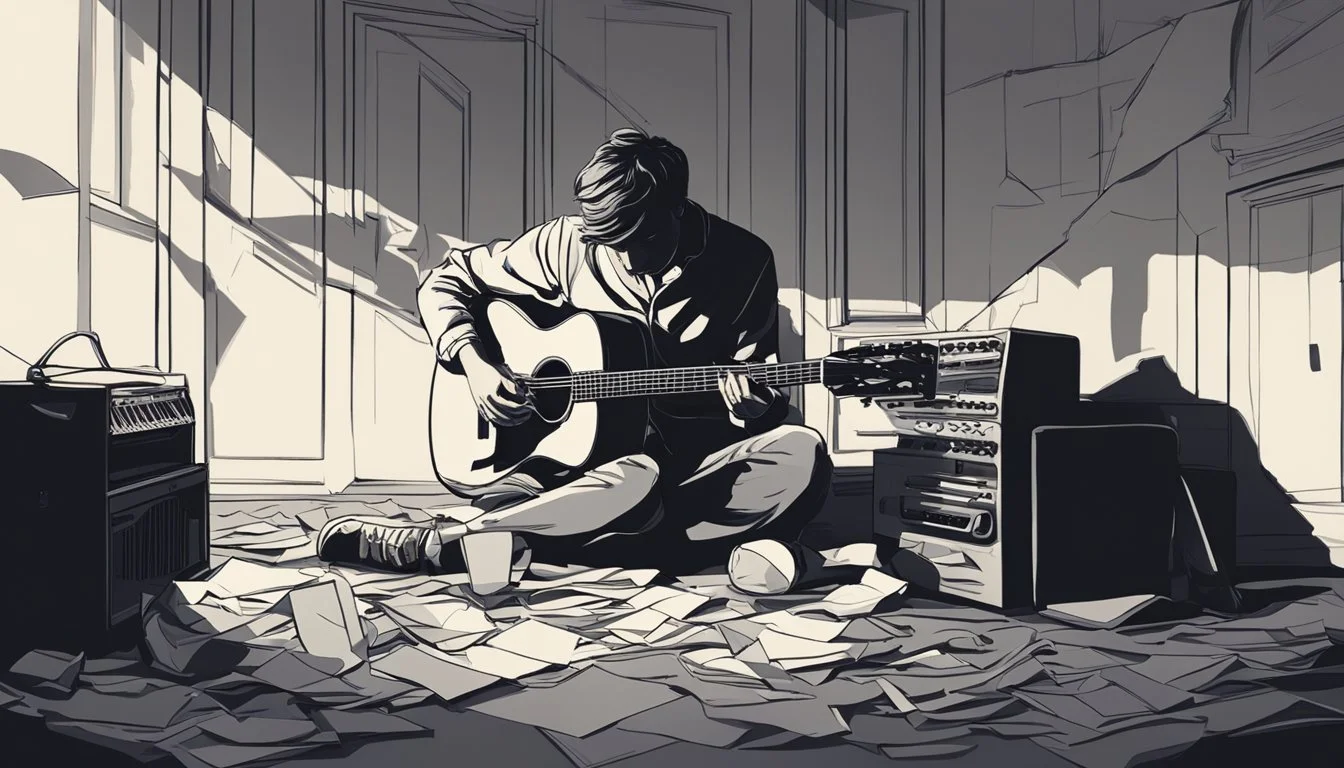Beatles' Blues: John Lennon's Battle with Depression
Unveiling the Hidden Struggles of a Music Icon
John Lennon, the iconic member of The Beatles, was known for his inspiring music and revolutionary spirit. Behind his public persona, however, lay a complex individual grappling with inner turmoil. Lennon's struggle with depression profoundly influenced his songwriting, resulting in deeply personal and emotionally charged compositions.
Throughout his career, Lennon used music as a vehicle to express his inner battles. Songs like "Help!" and "Help Me to Help Myself" serve as poignant examples of his cry for assistance. These tracks offer a glimpse into the mind of an artist who, despite his immense success, felt overwhelmed by his own emotions and experiences.
The contrast between Lennon's public image and private struggles highlights the often-misunderstood nature of depression. His ability to create powerful, resonant music while battling his own demons demonstrates the complex relationship between creativity and mental health. Lennon's openness about his struggles through his art has left a lasting impact, helping to destigmatize conversations about depression and mental well-being.
The Struggle Behind the Fame
John Lennon's public persona often masked deep-rooted pain and insecurity. His rise to stardom with The Beatles was accompanied by personal battles that shaped both his music and his identity.
The Early Years: Pain and Loss
John Lennon's childhood in Liverpool was marked by tragedy. At age 5, he was separated from his mother Julia and raised by his aunt Mimi. This early loss profoundly affected him, fueling feelings of abandonment and insecurity.
Music became Lennon's refuge and outlet for expressing his complex emotions. He formed his first band, The Quarrymen, as a teenager. This period saw him grappling with anger and sadness, which often manifested in his behavior and relationships.
Lennon's reunion with his mother Julia in his teens brought a brief period of joy. Tragically, she was killed in a car accident when John was 17, deepening his emotional wounds.
The Peak of Beatlemania and Personal Battles
As The Beatles skyrocketed to fame, Lennon struggled to reconcile his public image with his inner turmoil. The pressures of stardom intensified his feelings of isolation and self-doubt.
Lennon's song "Help!" (1965) was a thinly veiled cry for support. He later admitted it was "about me" and his difficulty coping with fame and personal issues. His use of drugs and alcohol during this period was partly an attempt to numb his emotional pain.
The creation of "Yer Blues" for the White Album (1968) showcased Lennon's raw emotional state. Its lyrics, "Yes I'm lonely, wanna die," starkly revealed his depression and sense of alienation at the height of The Beatles' success.
The Artistic Expression of Despair
John Lennon channeled his inner turmoil into powerful musical compositions. His raw emotions and struggles with depression found a compelling outlet in the Beatles' later work, particularly on the White Album.
Lennon's Lyricism and Vulnerability
Lennon's lyrics on the White Album reveal a deeply personal side of the artist. He bared his soul through introspective and often dark verses. In songs like "Yer Blues," Lennon confronted his inner demons head-on, singing candidly about feelings of isolation and despair.
His words painted vivid pictures of emotional pain, resonating with listeners who faced similar struggles. Lennon's willingness to expose his vulnerabilities in his music set him apart as an artist unafraid to confront difficult emotions.
The Sorrow in 'Yer Blues' and the 'White Album'
"Yer Blues" stands as a stark representation of Lennon's battle with depression on the White Album. The song's intense, gritty sound mirrors its heavy lyrical content. Lennon's anguished vocals and the band's raw performance create a visceral experience for listeners.
The track's bluesy style allowed Lennon to express his pain in a direct, unfiltered manner. Guitar solos punctuate the song, adding to its emotional intensity. Throughout the White Album, Lennon's contributions often touched on themes of isolation and introspection, reflecting his inner turmoil during this period of his life.
Interpersonal Dynamics and Friction
John Lennon's relationships within The Beatles were complex, marked by creative collaboration and personal tensions. His partnership with Paul McCartney shaped the band's sound, while interactions with George Harrison and Ringo Starr influenced the group's dynamics.
Collaborations and Conflicts within The Beatles
The Fab Four's creative synergy propelled them to unprecedented success. Lennon's songwriting partnership with McCartney produced numerous hits, but also sparked competition. Their differing artistic visions sometimes led to heated disagreements in the studio.
Lennon's acerbic wit and mood swings affected band interactions. He could be dismissive of Harrison's contributions, though he later expressed regret for this behavior. Ringo's easygoing nature often served as a buffer during tense moments.
The pressures of fame and individual growth strained relationships within the group. Lennon's experimental phase with Yoko Ono further complicated matters, leading to feelings of isolation from his bandmates.
Relationship with Paul McCartney and Band Members
Lennon and McCartney's friendship was the backbone of The Beatles. Their musical chemistry was undeniable, but their personalities often clashed. Lennon's raw, introspective approach contrasted with McCartney's more polished, commercial sensibilities.
As the band's career progressed, the Lennon-McCartney dynamic grew more competitive. They began writing separately more often, though still crediting songs to both names. This shift was evident in albums like "The White Album," where their individual styles became more pronounced.
Lennon's relationship with Harrison was sometimes strained. He initially underestimated Harrison's songwriting abilities but later came to appreciate his talents. With Starr, Lennon maintained a generally positive rapport, valuing his steady drumming and affable personality.
Journey for Inner Peace
John Lennon sought solace and stability through spiritual practices and meditation. His quest for inner peace led him to explore Eastern philosophies and teachings that profoundly influenced his life and music.
Exploration of Transcendental Meditation
Lennon delved into Transcendental Meditation (TM) in the late 1960s. This practice involves silently repeating a mantra to achieve a state of relaxed awareness.
TM offered Lennon a tool to manage stress and anxiety. He incorporated its principles into his daily routine, often meditating for extended periods.
The effects of TM were evident in Lennon's music. Songs like "Across the Universe" reflected his newfound spiritual awareness and cosmic perspectives.
Lennon credited TM with helping him find clarity and creativity during turbulent times. He spoke openly about its benefits, encouraging fans to explore meditation.
The Influence of Maharishi Mahesh Yogi
Maharishi Mahesh Yogi, the founder of TM, played a significant role in Lennon's spiritual journey. The Beatles met the Maharishi in 1967 and attended his lecture on TM in London.
Impressed by the Maharishi's teachings, Lennon and his bandmates traveled to India in 1968 for an extended retreat. This period was highly productive for Lennon, resulting in numerous songs.
The Maharishi's influence extended beyond meditation techniques. He introduced Lennon to concepts of universal consciousness and inner peace.
While Lennon's relationship with the Maharishi eventually soured, the impact of his teachings remained. Lennon continued to practice meditation and explore spiritual concepts throughout his life.
Lennon's Personal Relationships
John Lennon's personal relationships profoundly shaped his life and career. His connections with family, bandmates, and romantic partners influenced his music and public persona.
The Impact of Yoko Ono
Yoko Ono became a pivotal figure in John Lennon's life. They met in 1966 and married in 1969. Ono's avant-garde artistic approach inspired Lennon's experimental music. Their relationship faced public scrutiny and was blamed for The Beatles' breakup.
The couple collaborated on various projects, including albums and peace activism. Ono's influence extended to Lennon's political views and lifestyle choices. They separated briefly in 1973 but reconciled, remaining together until Lennon's death in 1980.
Ono continued to manage Lennon's legacy after his passing, preserving his memory through various artistic and charitable endeavors.
Friendships and Rivalries: From The Beatles to the Rolling Stones
Lennon's relationships with his Beatles bandmates were complex. His creative partnership with Paul McCartney produced numerous hits but also led to tensions. Their friendship deteriorated after the band's breakup, with public feuds and critical comments in the press.
George Harrison and Ringo Starr maintained varying degrees of closeness with Lennon over the years. The band's interpersonal dynamics influenced their music and eventual split.
Beyond The Beatles, Lennon formed friendships with other musicians. He admired Janis Joplin's raw talent and energy. Lennon also had a friendly rivalry with The Rolling Stones, particularly Mick Jagger, which fueled creative competition between the bands.
Exploring the Darker Side
John Lennon's struggles with depression were intertwined with substance use and experimentation. His personal experiences with drugs, particularly LSD, shaped his artistic expression and worldview during his time with The Beatles.
Substance Use and Its Effect
Lennon's battle with depression often led him to seek solace in various substances. Alcohol and marijuana were frequent companions, but it was his use of harder drugs that significantly impacted his mental state.
These substances temporarily alleviated his feelings of melancholy and personal isolation. However, they ultimately exacerbated his emotional turmoil. Lennon's drug use influenced his songwriting, with tracks like "Yer Blues" reflecting his inner darkness.
The song's raw, bluesy tone captured Lennon's deep-seated pain and existential angst. It stood out on the White Album as a stark representation of his personal struggles.
Lennon's Experience with LSD
LSD played a pivotal role in Lennon's artistic and personal journey. He first experimented with the psychedelic drug in 1965, which profoundly altered his perception of reality and creativity.
The mind-altering effects of LSD intensified Lennon's introspective tendencies. It amplified his feelings of disconnection and fueled his exploration of consciousness.
His LSD experiences seeped into Beatles' songs, influencing their psychedelic phase. Tracks like "Tomorrow Never Knows" and "Lucy in the Sky with Diamonds" bore the hallmarks of his acid-induced visions.
However, LSD use also deepened Lennon's struggle with depression. The drug's after-effects often left him grappling with heightened feelings of isolation and existential dread.
Coping Mechanisms and Artistic Outlets
John Lennon turned to music and creative expression as crucial outlets for managing his emotional struggles. His art became a powerful tool for self-reflection and healing.
The Role of Creativity in Lennon's Life
Lennon's songwriting served as a vital coping mechanism for his depression and insecurities. He channeled his inner turmoil into lyrics and melodies, transforming pain into art. This creative process allowed him to externalize his feelings and find temporary relief.
Lennon often used metaphors and clever wordplay to disguise deeply personal messages in his songs. This artistic approach helped him communicate difficult emotions while maintaining a sense of control over his public image.
Reflective Songs and Messages of Healing
"Help!" stands out as one of Lennon's most direct pleas for support. The upbeat melody masks lyrics that reveal his vulnerability and need for connection. This song exemplifies how he used his art to process complex feelings.
Later in life, Lennon wrote "Help Me to Help Myself," showcasing his ongoing struggle with inner demons. The track's raw honesty reflects his evolving approach to addressing mental health through music.
Lennon's solo work often delved into themes of self-improvement and emotional growth. Songs like "Imagine" and "Give Peace a Chance" promoted healing on both personal and societal levels.
The Tragic End and Its Aftermath
John Lennon's life was cut short by a senseless act of violence. His death sent shockwaves through the music world and beyond, but his legacy continues to inspire and influence generations.
The Assassination of John Lennon
On December 8, 1980, Mark David Chapman fatally shot John Lennon outside his New York City apartment. Chapman, a troubled fan, had asked for Lennon's autograph earlier that day. He waited outside The Dakota building and fired five shots when Lennon returned that evening.
Lennon was rushed to Roosevelt Hospital but was pronounced dead on arrival. The news of his murder stunned the world, prompting an outpouring of grief from fans globally.
Chapman later claimed he was motivated by a desire for notoriety and a warped interpretation of J.D. Salinger's novel "The Catcher in the Rye."
Legacy and Memory: The Continued Influence
John Lennon's impact on music and culture endures long after his death. His solo work and contributions to The Beatles continue to inspire musicians worldwide.
The Beatles Anthology project, released in the mid-1990s, introduced Lennon's music to a new generation. It featured previously unreleased recordings and new songs created using Lennon's demos.
Yoko Ono established the Strawberry Fields memorial in Central Park, New York. It serves as a place of reflection for fans and a symbol of Lennon's message of peace.
Lennon's songs like "Imagine" and "Give Peace a Chance" remain anthems for social change and harmony. His art, activism, and personal struggles continue to resonate with audiences decades after his tragic end.
Cultural Impact and Enduring Legacy
John Lennon's influence extends far beyond his music, shaping culture and society in profound ways. His work continues to resonate with audiences worldwide, inspiring new generations of artists and activists.
Lennon's Influence on Music and Culture
Lennon's songwriting revolutionized popular music. His introspective lyrics and innovative compositions pushed the boundaries of rock and roll. Songs like "Imagine" became anthems for peace, showcasing Lennon's ability to blend social commentary with memorable melodies.
His outspoken nature led to controversy, particularly with the "More Popular Than Jesus" comment. This incident highlighted Lennon's cultural significance and the media's intense focus on The Beatles.
Lennon's solo work further cemented his status as a musical icon. Albums like "Plastic Ono Band" and "Imagine" demonstrated his artistic growth and willingness to explore personal themes in his music.
Beyond the Beatles: The Global Phenomenon
After The Beatles' breakup, Lennon's influence continued to grow. His activism for peace and social justice resonated globally, inspiring movements and individuals to champion these causes.
The Beatles Anthology project in the 1990s introduced Lennon's work to new audiences. This revival showcased the enduring appeal of his music and message.
Lennon's recording sessions, both with The Beatles and solo, are studied and revered by musicians and producers. His innovative studio techniques and willingness to experiment continue to influence modern music production.
His tragic death in 1980 only amplified his cultural impact, transforming Lennon into a symbol of peace and artistic integrity that persists to this day.










